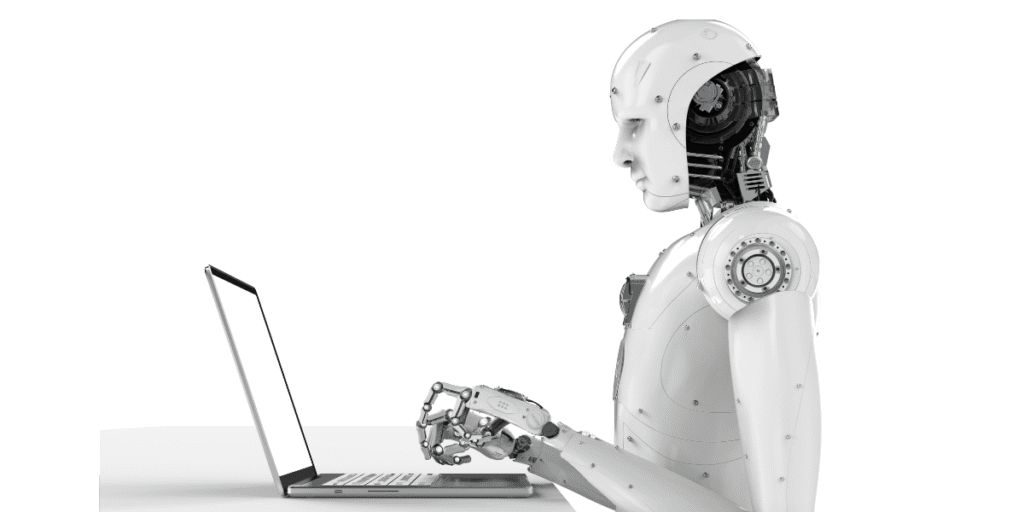
The pace at which Artificial Intelligence writing software has developed is simply mind-blowing!
Believe it or not, we are now at the stage where artificial intelligence (AI) software is capable of writing stories!
Using machine learning and experimental algorithms, creative coders have been able to develop programs that are capable of producing short stories, poetry and even novels!
The expansion of machines and bots into the realm of content creation undoubtedly has the potential to turn blogging and other forms of content marketing on their collective head with absolutely nothing being the same again.
If you’re anything like me, you’ll need to be ahead of the curve on the emergence of AI writing software. So let’s jump into the red pill world of artificial intelligence to definitively answer: can AI software write stories?
We will look at how AI writing works and some notable AI writing solutions coming to the market that could completely take over your content production, or at least lighten the load.
And if you are wondering…no, I’m not a bot. Let’s get into this.

If the term artificial intelligence creative writing brings to mind a robot in Starbucks with a soy latte, fretting over the Oxford comma, we’ve got some explaining to do.
It’s not surprising really because, with so much talk about the 4th industrial revolution, automation and the replacement of workers with machines, it’s easy to think that there are sentient bots just waiting to pitch you a blog post.
So what is artificial intelligence?
Artificial intelligence (AI) is the demonstration of intelligence by machines, usually computers.
It is different from the sentience and consciousness of man and is more closely related to being able to understand a required task, carry it out, and learn from mistakes or improve performance on the next attempt.
AI is scientifically described as the study of intelligent agents, with incremental progress being made towards devices that have an understanding of their environment and the ability to take steps to enhance their performance at achieving specific goals.

Right now, at best we are talking about mimicry of writing produced by a human through AI using what could be described as cognitive functions like learning and problem solving; much like the supercomputer in the 1983 hit film, WarGames.
Even though it seems like AI technologies are the future, we are already using AI continuously for everyday activities
The late AI computer scientist Larry Tesler described AI as “whatever hasn’t been done yet.”

Often when computers excel at an automated task they cease to be recognized as Examples of artificial intelligence technologies we take for granted include:
- Search engines
- Video games
- Virtual Assistants like Amazon Alexa or Google Assistant
- Chatbots
- Writing assistants like Grammarly
- Portrait photographic settings on Android and iPhone smartphones
- Tesla automated vehicles
Which brings me on to writing…
Advancements in artificial intelligence technology for copywriting have come a long way since that cheerful paperclip Clippy popped up on our screens in Office 97.
It is almost unbelievable but as I write this, leading news organizations and outlets like the Associated Press and the New York Times already generating tens of thousands of original news stories each month using AI technology.
The vast majority of these rather formulaic news stories deal with the basic who what where why and when of people, places and events and arent really creative at all.

Though we’re not talking about Pulitzer prize-winning journalism, what excites me is the volume and coherence of content that is being created. See if you can tell if a bot wrote these excerpts in this New York Times quiz.
Associated Press benefits from increased productivity from their newsroom journalists who can be directed to other tasks than authoring generic news bulletins. If that is good enough for global news networks, it could be good enough for affiliate marketers like us.
How does artificial intelligence software write content?
AI writing software processes and creates its written content using a software process called Natural Language Generation (NLG).
NLG can source its data inputs from a variety of sources to produce a text-based output that has natural linguistic elements, imitating how humans speak or communicate.
This technology has been around for far longer than you would think with ELIZA, a natural language processing program capable of discourse, being invented and run by the Massachusetts Institute of Technology (MIT) in the 1960s.
Nowadays, it is routinely used to create healthcare or business reports, predictive text, social media posts and the news bulletins mentioned above.
Machine learning, including the use of Long Short-Term Memory algorithms, enable NLG systems and tools to be created through crawling large volumes of writing that have been authored by humans.
You may have encountered this type of writing AI with software-generated captions for images or YouTube videos.
AI writing technology will need to be programmed according to the type of content that needs to be produced. This is called the template or narrative type.
The data inputs into NLG software, therefore, includes examples of the writing style and structure of the text format to be produced. Inputs are determined by software programmers or end-users or the AI writing program.
The input data is the food that the NLG software feeds on to generate content.
The data, that may be text, audio or video, must be licensed, owned, and available in sufficient volume for the AI program to ‘learn’ the writing style and draw from it to produce credible writing.
Google’s Text to Speech and Amazon Polly are examples of NLG tools that are rich in this essential data.
Input data has such a significant impact on the quality of the writing output that some news agencies have in-house NLG tools to boost the efficacy of their AI writing platforms.
With an arsenal of NLG-based software solutions, large amounts of data can be efficiently processed and reported, at a rate that humans cannot match.
The content produced can also be personalized to an increasingly complex level, meaning that thousands of unique documents, with less of the canned effect, can be generated simultaneously.
Getting creative with AI software
To create the type of sophisticated, stylized writing needed for creative writing content like stories, the AI technologies used need to be capable of moving beyond glueing together snippets of canned text in a coherent manner.
The creation of a story will require much more planning and careful, nuanced synthesis of the information to maintain the natural appearance along the entire length of the story, avoiding repetition.
Key stages of the AI story writing process
- The AI program needs to decide what the story will mention: This stage involves the AI program deciding what information will be included in the story, with prioritization of particular narrative elements and information.
- A structure for the story needs to be developed: Of course, stories have a beginning, middle and end, and the software will process the overall organisation of the required piece of fiction.
- Aggregation of linguistic data: As the story is composed, the AI algorithms will decide the appropriateness of particular words and phrases for a natural readable text and coherent progression of the story.
- Decision making: Creative writing AI needs to be able to decide on whether the expressions and writing style it uses are effective for the document being produced.
- Realization: Putting together the completed story according to the normal rules of writing and recrawling the entire text for mistakes.
So what are AI stories like?
Many creative writing developers use an open-source AI software called Generative Pre-trained Transformer 2 (GPT-2).
It is popular because it is capable of achieving a quality of text output that is can be indistinguishable from human writing.
Coherent paragraphs can be strung together to create stories or other forms of creative writing. Booksby.ai is filled with examples of GPT-2 stories. What do you think?
As you can see, the results are remarkable, but as with many technologies, there is still a lot that needs to be ironed out.
Expectations definitely need to be curbed as AI is not currently writing Bronte or Austen calibre stories, though coders are having a lot of fun with experimentation.
Glitches abound
In particular, AI does struggle with sustaining a plot and maintaining characters and themes.
Where AI-generated novels have been produced, human co-authors have been drafted in to make the software output into something more cohesive and readable.
So what does this all mean for blogging and affiliate marketing?
Creative writing AI represents the cutting edge of what this type of automated technology can do.
And if AI software can produce credible stories and novels I’m thinking it can certainly handle some blog content for my sites.
The blogging world is eagerly awaiting the emergence of AI writing software, which is expected to completely disrupt how blog content is produced.
And I have to let you in on a big secret. I have tried it, and I have to say I have found it helpful, in part (more on this below).
It’s easy to see how having AI could completely transform content creation for affiliate marketing. Here are just some of the benefits of AI writing software I am looking forward to enjoying:
- Super-charged productivity. The production of blog posts and other forms of written content is the most time-consuming aspect of running successful blogs. Of course, content creation can be outsourced to human writers but AI software writes articles at a pace that cannot be matched by hands. We are talking about a few minutes in most cases for a simple blog. This means that you could generate massive growth for your blog in a very short time.
- Data-driven content production. Machine learning technologies like AI writing tools learn how to produce well-referenced blog posts from existing blog content and relevant sources. This means that the content produced is well-sourced and engineered to be authoritative and high-conversion.
- Content that is search engine ready. Because AI software is carefully programmed and trained with robust rules, they can produce content that complies with the requirements of the major search engines, meaning better easier ranking and better SERPs.
- Cost-effective bulk content production. Like most SaaS, AI software platforms offer monthly subscriptions that are expensive but demonstrate their value when you consider that they can produce tens or even hundreds of thousands of words per month. When you compare that with the costs of a blog content writing service or the other places where bloggers get their content, you could be making significant financial gains that can be used to expand the scope of your other projects.
Testing the waters of AI content creation with Jasper.AI
In the hope of bolting on benefits like these to my bottom line, I am tentatively testing the waters of artificial intelligence content production by testing a powerful copywriting assistance tool called Jasper.AI

Click this link to get 10’000 words for FREE
This is enough to get 2-3 articles and test it out for yourself.
Now you may have heard about this software as it is blowing up everywhere and I wanted to see what all the fuss is about.
I’ll have to admit that this software is a hard worker being able to do amongst other things:
- Produce full blog posts of up to five thousand words in length.
- Yes, this software can write stories!
- Author personal bios for social media.
- Create meta-descriptions.
- Generate YouTube intros.
The functionality this software offers is amazing, but I am still testing its long-form functionality, so you will have to bear with me for my thoughts on how it all works and whether it will be useful long term. I share more of my thoughts in this video:
So, it seems the story of AI-generated affiliate marketing content has just begun
I have NOT yet put my writers out to pasture, but as you can see AI writing is continually improving and expanding in scope. It is as tool that at the moment I use to help my writers, but not replace them.
Tools are a big part of the way I work so I will be taking my time to see how AI writing fits in. So, watch this space for the rise of the machines.
